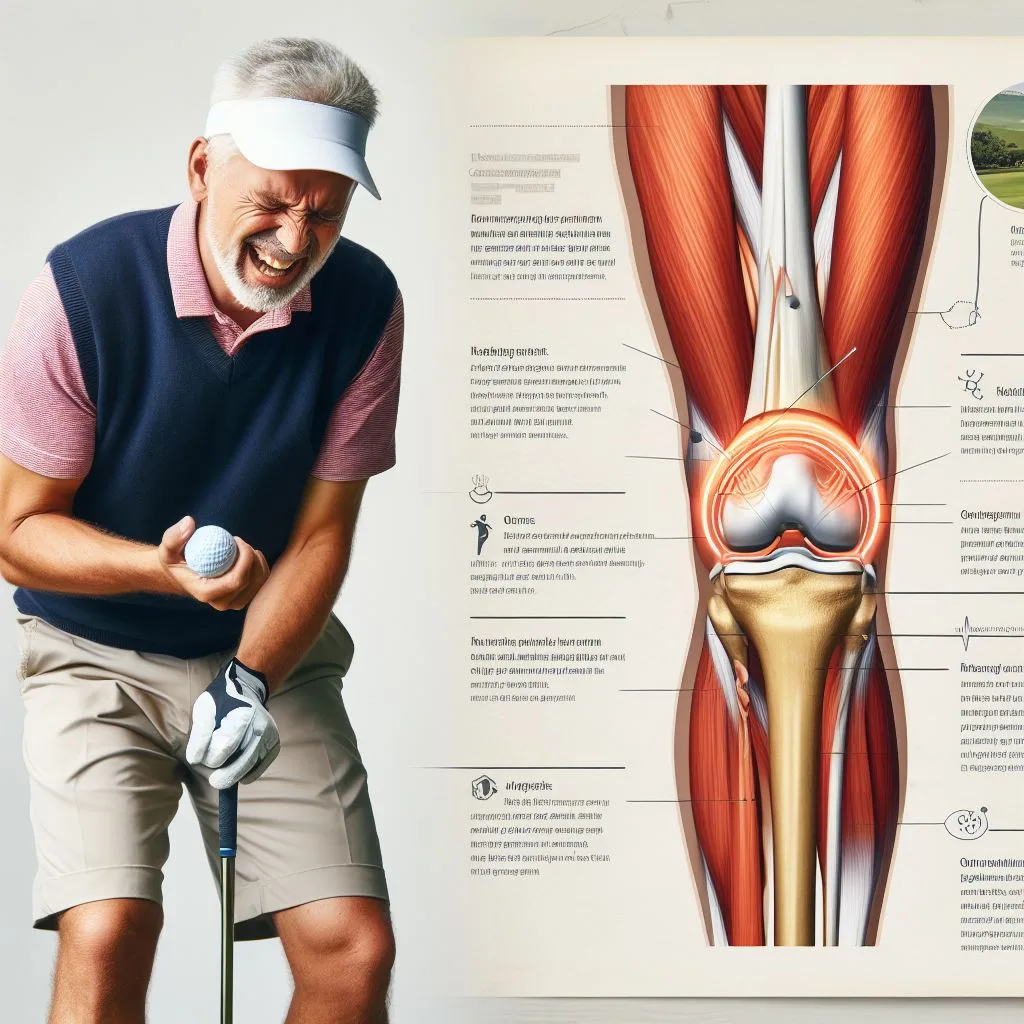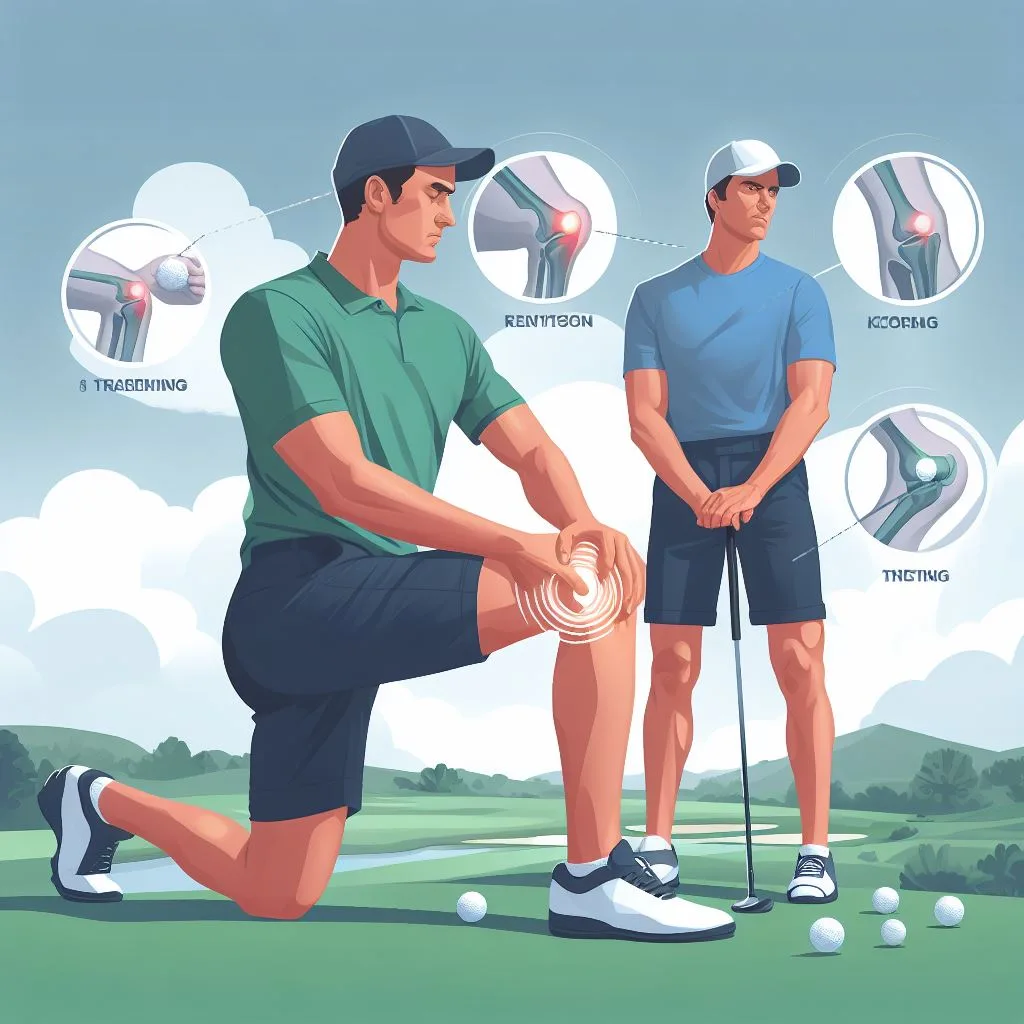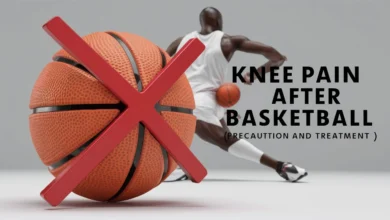Common Golf Knee Injuries: 6 Powerful Ways to Prevent and Overcome

Yes now we talk about common golf knee injuries. Despite its reputation as a low-impact sport, golf gives fans an opportunity to enjoy the great outdoors and stay active. It does, however, carry a unique set of risks, just like any sport. Knee injuries are notably prominent among these. When straightening the leg, some people may ignore a slight discomfort or sharp pain in the knee; however, this could result in a longer recovery time or even disability. Let’s examine more closely the typical knee injuries that golfers sustain and how to avoid them.
Contents
Why Golf Can Be Hard on the Knees

Golf-specific supportive shoes can also be beneficial since they improve shock absorption thanks to their cushioned insoles. As needed, players should take pauses to avoid overusing injuries.
Common Knee Injuries in Golf
Medial Meniscus Tear:
Golfers frequently suffer from a medial meniscus tear, a knee injury caused by repetitive strain throughout the swing. This cartilage structure lubricates, stabilizes, and absorbs shocks to the knee joint. It is situated between the femur and the tibia. Pain, edema, stiffness, and a restricted range of motion are possible side effects. Regardless of age or ability level, amateur and professional golfers are both vulnerable to this ailment. Golfers should be aware of the procedure, practice good form during swings, and wear appropriate, supportive footwear to avoid long-term injury.
Osteoarthritis:
Golfers who have osteoarthritis suffer from joint discomfort, stiffness, and swelling as a result of this degenerative disease. While it may not be the primary cause, it can make pre-existing conditions worse. Golfers who wear knee braces, use supporting equipment, and exercise regularly can avoid future harm. Osteoarthritis risk can be considerably decreased by seeking medical advice early in life. Golfers can keep playing their favorite sport without suffering new injuries or knee degradation by altering their lifestyle and reducing joint stress.
Preventing and Treating Golf Knee Injuries
Strengthening Exercises:

Daily Stretching:
Stretching on a daily basis is essential for improving sports performance and avoiding typical golfer’s knee ailments. Maintaining flexibility and lowering the risk of strain or tear can be achieved by concentrating on the quadriceps, hamstrings, and glutes. While tight quadriceps can exacerbate knee discomfort and injury, tight hamstrings can restrict range of motion. Because swinging involves repeated motion, stretching on a regular basis can help avoid tendinitis or muscular strains.
Post-Game Care:
Ice packs applied to the injured area can help relieve knee pain following a round of golf. Ice speeds up healing by reducing swelling and inflammation. For best results, adhere to the 20-minute on, 90-minute off rule. Steer clear of overexposure to burns or other skin injuries. Put consistency first and ice for little periods of time every day. Steer clear of applying ice straight to exposed flesh to prevent burns or numbness. For safe application, cover the ice pack with a towel or piece of cloth.
Supportive Gear:
Golfers can avoid and treat knee injuries with the use of kinesio tape and knee braces. Contemporary knee braces provide support and compression without limiting range of motion, easing pain and lowering the chance of additional damage. Golfers with MCL sprains or ACL injuries will benefit most from them. During the golf swing, kinesio taping supports the knee joint and provides full range of motion. By separating the skin from the underlying tissue, it improves muscle activation, encourages appropriate alignment, and lessens pain. However, before utilizing this supportive equipment, it is imperative that you speak with a healthcare provider.
Listen to Your Body:

Physiotherapy: A Golfer’s Best Friend
A key component of golf is physiotherapy, which works to strengthen and stabilize the muscles surrounding the knee joint. Golf swings can put stress on joints and ligaments because they entail repeated twisting and rotating motions. Physiotherapists can help golfers become more balanced, flexible, and in control of their muscles, which lowers their risk of knee problems and improves their game. Additionally, they offer customized injury prevention plans, recommending posture or swing adjustments to lessen knee strain while preserving accuracy and power. Stretches and warm-up workouts can focus on injury-prone muscles, including the hamstrings, hip flexors, and quadriceps. For golfers looking to improve their game and maintain long-term mobility, physiotherapy is an invaluable resource.
FAQ’s
What is the most common knee injury in golf?
Golfers frequently suffer from golfer’s knee, also known as patellar tendinitis, as a result of repetitive strain. It happens when the tendons that connect the shinbone to the quadriceps muscles become inflamed. Significant twisting or rotating pressures can result in meniscus tears, which can cause pain, edoema, and limited range of motion. Focus on good technique, do strength training activities, and get good shoes if you want to avoid knee issues. The risk of knee injuries can be considerably decreased by taking preventative steps and exercising mindfully.
How common are knee injuries in golf?
Roughly 10% of all golf-related injuries that are treated in hospitals are knee injuries. Sprains or rips of the medial collateral ligament are the most frequent injury, frequently brought on by rotational stresses during the swing. Strengthening exercises, stretches and warm-ups, and appropriate, cushioned footwear are examples of preventive techniques. In order to prevent injuries and maintain a long-lasting pleasure of the game of golf, it is imperative to be aware of typical golf-related knee injuries.
How do you treat golfer’s knee?
Patellar tendinitis, sometimes referred to as jumper’s knee or golfer’s knee, is a common condition that affects golfers. It makes the area below the kneecap painful and irritated. A variety of techniques, such as stretching and strengthening exercises, wearing supportive shoes, and speaking with a physical therapist or sports medicine professional, are required to address it. This calls for perseverance, commitment, and adjustments to game strategy to reduce recurrence and increase recovery possibilities.
Can golf swing cause meniscus tear?
Popular activity golf can lead to knee injury, especially meniscus tears. The meniscus may tear as a result of twisting pressures brought on by the rotation and torque produced during the swing. Golfers should utilize appropriate equipment, maintain proper posture, be aware of their swing’s biomechanics, and engage in regular exercise to develop their knee muscles. Meniscus tears can be more common in older adults and those with pre-existing knee issues, so it’s important to take care of your knees both on and off the course.
Conclusion: Common Golf Knee Injuries
Despite its reputation as a leisurely sport, golf demands a great deal of skill, accuracy, and physical endurance. Knee strain occurs when players have to calculate their swings, which involves elements like wind speed and distance. Golfers of all skill levels frequently suffer knee problems, which can result in meniscus tears and ligament strains. Golfers must be aware of these risks in order to avoid injury. Knee strain can be decreased by using proper technique, which includes maintaining proper posture and avoiding excessive rotation. Stretching is one preventive measure that can increase agility and flexibility.
Also Check: Reviving the Thrill: Cycling After Knee Replacement Surgery





One Comment